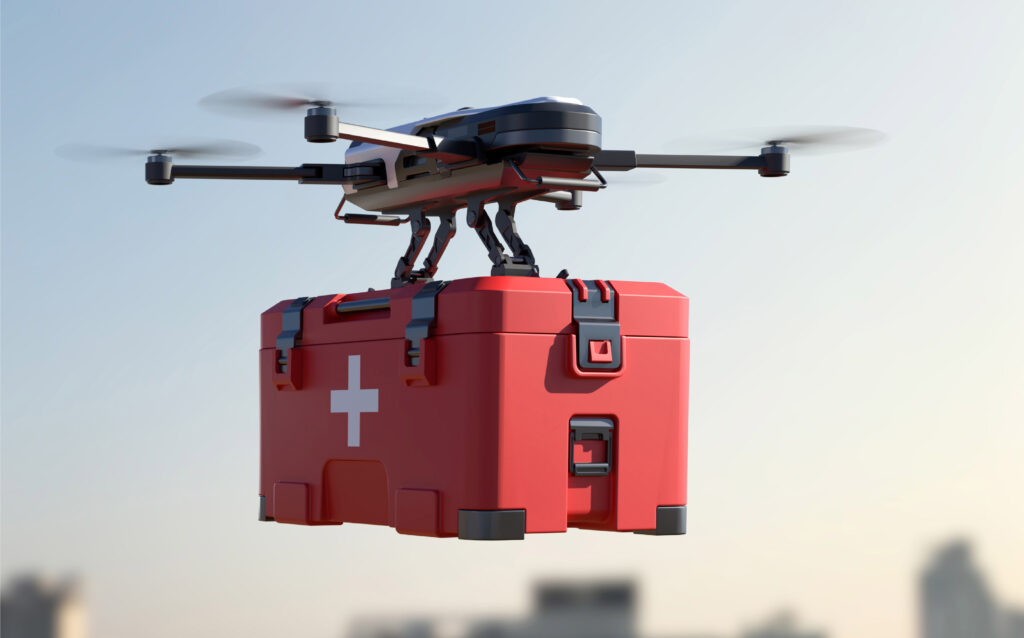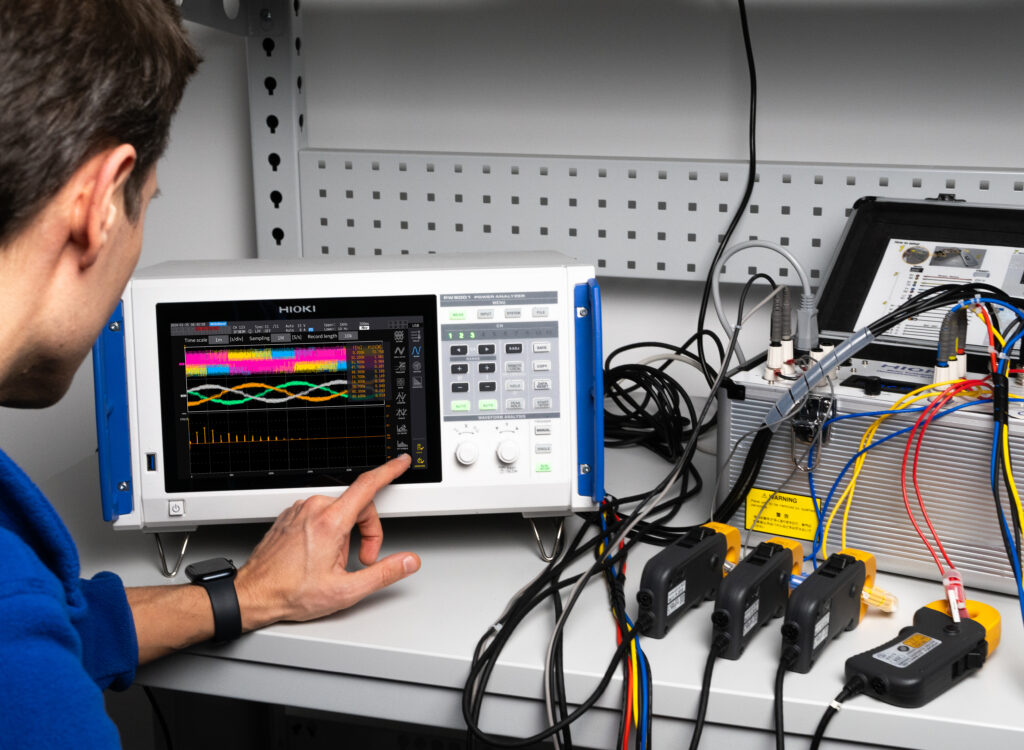A new generation power analyzer sets a new industry standard with unrivalled accuracy, providing the best solution for high-frequency and high-power measurements. This allows ultimate efficiency measurements from state-of-the-art SiC and GaN based applications to complex multi-motor drivetrain power analysis.
Perfect for SiC and GaN applications
If you look at publications focused on power electronics, you can draw no other conclusion than that SiC and GaN semiconductors are the future. That is not surprising when you consider the advantages that the use of these new semiconductors offers.
SiC and GaN semiconductors make it possible to further improve the efficiency of the power converters while the size and weight of the converters can be reduced.
But, as always, there are also a downsided. SiC and GaN semiconductors are operating at switching frequencies starting from 100 kHz up to several MHz’s. Accurate power measurement becomes quite a challenge under these conditions…
For example, the bandwidth of the measuring system must be considerably higher than what was considered sufficient until recently. This requires an increased sampling frequency.
The higher switching frequencies of the SiC and GaN semiconductors cause an increase in electromagnetic disturbance, so the measuring system must be more resistant to the increased electromechanical radiation.
Every current sensor has the nasty property of causing a time delay. This has no noticeable effect on the accuracy of the power measurement at low switching frequencies but will certainly play a considerable role at higher frequencies. Without effective compensation for the time delay, it is impossible to perform an accurate power measurement at higher switching frequencies.

The need for improved accuracy at high switching frequencies is easily explained when you consider that the efficiency of EV drivetrains exceeds 95%. To be able to proof adjustments in the system lead to further efficiency gains, the measurement system must be able to demonstrate the efficiency has increased from 97.5% to 97.6%. Taking all the above-mentioned challenges in consideration, you must admit that there are quite a few hurdles to take to come to accurate and reliable results for SiC and GaN based applications.
The HIOKI PW8001, in combination with the HIOKI current sensors, is the perfect choice for this challenge. The industry leading power accuracy for both DC and high frequencies, combined with the unprecedented Common Mode voltage Reduction Ratio (CMRR) for both the PW8001 and the HIOKI current sensors, guarantee extremely accurate and unaffected measurements, even in extremely noisy environments.
Power Analyzer for 1500 V DC CAT II
The trend to more powerful solar farms has led to an increase of operating voltage. Nowadays 1500 V DC has become the standard. Further, solar farms are combined with local storage solutions for grid balancing purposes or to provide 24-hour energy. Another area where higher voltage is becoming more common is the electrification of heavy trucks and busses. While regular EVs use 400 V DC or 800 V DC systems, the transport sector is moving to 120 V DC to increase system power and to reduce charging time.
To provide a power measurement solution for these new technology trends HIOKI has developed the U7001 high voltage input module. With the U7001 HIOKI is the first on the market with a 1500 V DC CAT II benchtop power analyzer. This classification makes it possible to use the PW8001 for the development and production testing of solar power conditioners, drive trains and fast charging solutions for heavy (H)EVs with system voltage of more than 1000 V DC.
4-motor drive system analysis
Nowadays drones are in use in a wide range of applications, like making bird’s eye view videos, surveillance, inspections in hazardous environments or package delivery. AED-drones, which are equipped with a defibrillator, can even save lives because they can arrive earlier than an ambulance at the places of emergency in crowded places like festivals or city centers. Other companies are even developing larger and more powerful drones like taxi-drones.
For all these drones the efficiency and reliability of the drive train is extremely important, because every increase in efficiency will lead to an increase in range. The PW8001 with the 4-motor evaluation option is the perfect development tool for drones and other 4-motor drive systems like performance EVs, electrical busses with in-wheel motors and industrial robots. It allows you to analyze the performance of the 4 motor drives simultaneously, which makes balancing of the drive train a lot quicker and easier and will result in more efficient and reliable designs.
Automatic Phase Shift Correction
During the design of booster choppers for (H)EV’s or active Power Factor Correction systems for the Grid, power loss measurement of the reactors and transformers is very important. The inductive nature of these components makes it difficult to measure accurately, especially at high frequencies. One of the reasons for this is that the voltage and current need to be measured exactly at the same time to be able to measure the active power. Current sensors however will always have a time delay.
So, to be able to measure the loss of a reactor or transformer accurately the time delay of the current sensors needs to be eliminated over the full frequency range.
For this reason HIOKI has implemented a phase shift correction function as a standard years ago, which has now been improved to an easy “plug-and-play” function that does not require manual input as Automatic Phase Shift Correction function (APSC). This new and unique function is firstly available with the new Power Analyzer PW8001. The APSC function ensures unmatched performance for loss measurements of high frequency reactors and transformers.
To make the APSC function work properly two things are required:
- the current sensor with a known constant time delay
- the Power Analyzer that is able to compensate for the time delay
Being the only manufacturer of Power Analyzers who also designs and produces current sensors, HIOKI is in the unique position to optimize the current sensors for the APSC.
The HIOKI current sensors in the CT68- and CT69-series have been designed to achieve a constant time delay over the full frequency range, as shown in figure 2.
Due to this unique feature the PW8001 can compensate for the time delay of the current sensor regardless of the frequency it is measuring. Other current sensors on the market tend to be designed with a focus on a low phase shift at high frequencies. As a consequence these current sensors will not have a constant time delay over the full frequency range. This is illustrated in figure 3 where the time delay of a comparable sensor available on the market is shown.
As the time delay of the comparable sensor varies between 100 ns and 20 ns, this makes it clear that this design makes the current sensor unsuitable for phase shift correction, as the Power Analyzer is not able to compensate for the time delay at all frequencies it’s measuring.
Also positioning of the conductor in the current sensor can influence the accuracy of the measurement. This is illustrated in figures 4 and 5.
In figure 4 all curves are exactly on top of each other which shows there is no influence on the phase delay due to conductor position.
The same tests has been performed with a comparable current sensor and the result is shown in figure 5.
The results are quite different. In this case the conductor position has influence on the phase delay at frequencies higher than 100 kHz, and will have influence on the overall accuracy of the power measurement at high frequencies like with the use of SiC and GaN semiconductors.
Ultimate flexibility
The increasing complexity of power applications like integrated solutions for renewable energy with local storage, grid connection and EV charging, require an increase of power channels to be able to analyze the dynamic power behavior of a system.
The PW8001 with its modular 8-channel power inputs in one instrument, the free choice of U7001 high voltage and U7005 high precision input modules and the excessive range of current sensors from 20 A to 2000 A, provides you with the possibility to compose your “tailor-made” power measurement solution.

